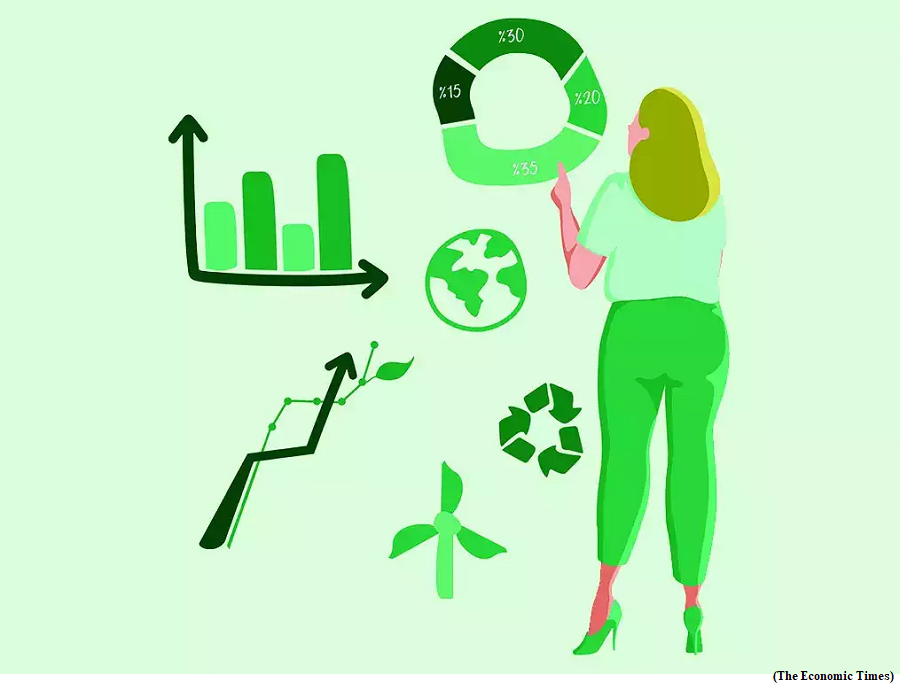India’s own green taxonomy (GS Paper 3, Economy)

Context:
- India has made emphatic inroads into developing sustainability-related policies and regulations.
- India’s green transformation will use digital technologies, and develop newer business models to steer the various shades of green, in the current brown-to-green transition movement.
Lack of Green Funding:
- For effecting climate mitigation and adaptation towards its Net Zero journey, it will need annual investments of upto 8% of GDP, and upto $15 trillion in all. Domestic private and government capital will not be sufficient to cover these green-bills.
- There is a significantly large availability of green funding globally. The signatories to the UN-backed Principles for Responsible Investment together represent over $150 trillion in assets under management.
- The sustainability indexed funds, benchmarked to environmental, social, and governance indices, have another $300 billion.
- The impact investing world has another $1 trillion to add to the green shift. Despite these, the share of global private financing in green is less than 5%.
Engaging Banks:
- Going green in India has largely been politically pushed, via policies impacting industry. The Indian financial stakeholders, especially the banks, have been very slow in their green-financing efforts.
- The banks, like their peers in many parts of the globe, seem to have not factored in climate risks and the need for financing climate action. A 2022 industry assessment notes none of the 34 Indian banks tested had climate-change resilience on their portfolios.
- Financiers must understand that green financing is not just ‘affirmative action’,it is a business opportunity.
- Bankers understand risks well, especially those defined and measured by regulatory supervisors. For climate risks, the banking sector needs to have a new set of acceptable definitions. Lenders are used to assessing the lending risk in terms of credit, market, liquidity, and business risks.
New paradigm:
- RBI could help its goverened entities by defining what constitutes green risk. Indian financial regulators must ensure adequate green-training to the directors and trustees of their licensed entities.
- There is a lack of consenus, across the financial services sector in India, on what green finance and its environmental impact are. One of the basic aspects of a financing system is agreed-to definitions, nomenclature, measurements and units, and difference-resolution.
- While there are many green taxonomies globally, with varying layers of confusion and critique, India needs its own. This has to factor in the cultural nuances, geographic issues, market intelligence, scientific temper and ability to keep it simple.
Green taxonomy:
- Only a deeply incisive taxonomy can help India tap into global green funding. Its green economic activities have to align with the taxonomy.
- Detailed green taxonomy will not only move Indian NetZero goal ahead but also allow for efficient deployment of green-capital and more accurate reporting of progress. India faces significant social and environmental challenges.
- A green taxonomy can help to promote social responsibility by encouraging investment in activities that support sustainable development like affordable housing, access to clean water, and sustainable agriculture.
- Investors globally rely on green taxonomies for their investments. They are wary of both green-washing as well as green-shaming. Standardised definitions are their true-north for investing in credible green investment opportunities.
- Articulate green taxonomy can offer information symmetry and avoid plurality of commercial green interpretations.
Conclusion & Way Forward:
- Global investors ask for uncomplicated and non-politicised green taxonomy. The assessment and disclosure of climate risks, while needed for India’s financial resilience, are also an opportunity for its financial players to participate in its green transition. It is both an economic window, and a store of social good.
- Once a green taxonomy is in place, it has to cascade across detailed standardised investor-friendly disclosures, across all regulatory, markets and corporate interfaces. That’s what can lend credibility and ease of regulatory aspects for green-lending to happen.
- It would be useful to engage with the banking sector to bring their green-concerns to the table. An effective banking sector can bring to the discussion, their end user understanding and what could constitute green-risks, and what can avoid both green shaming as well as green washing.
- As RBI regulates those entities, has the knowledge, and the global connect to understand what could work within possibilities of Indian financial systemic stability, it should take the lead in shaping GreenT, the Indian Green Taxonomy.


